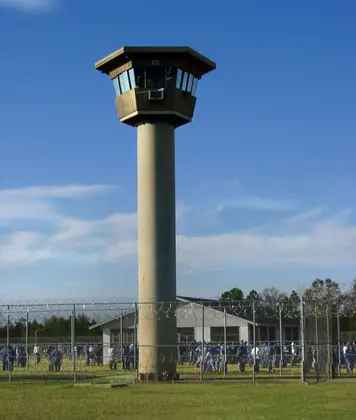As prisons across the U.S. look to reduce manpower and cut costs, those considering unstaffing towers in favor of monitored cameras and sensors are drawing the ire of unions who say officers — and prisoners — are being put in danger.
"No camera has ever stopped someone from being beaten up," said Ed McConnell, executive vice president of the Pennsylvania State Corrections Officers Association. "… When you need help, a man with a gun does it. … A camera doesn’t help you."
Pennsylvania is evaluating whether it needs officers constantly on tower duty, saying it could save nearly $5 million a year by joining the ranks of states including Ohio, Connecticut, California, Colorado, Florida and others that have made similar moves.
"They’ve become pretty much obsolete," John K. Murray, superintendent of the Camp Hill prison in central Pennsylvania, said of towers. "Towers are kind of the dinosaur way of doing our business."
Pennsylvania corrections officers already monitor cameras inside prisons. The projected savings would come from a reduction in overtime, because there would be more officers inside the prison to help fill in when others are out sick or on vacation.
"It would be a better use of our resources to take them out of the towers and put them inside the institutions," department spokeswoman Susan McNaughton said.
Only five of 27 state facilities even have perimeter towers because of changes in prison design; Pennsylvania hasn’t built a prison with them since the 1960s. The Corrections Department hopes to have those changes in place by June.
In some states, the tower guards are long gone at most prisons. Connecticut started reducing tower staffing in the mid-1990s and now has only two prisons that staff towers, and even then only during selected times, said Andrius Banevicius, a spokesman for the Connecticut Correction Department.
The California corrections agency started taking officers out of prison towers in 1993, a year after it started installing lethal electric fences. The move saved $70 million a year in staff costs, spokeswoman Terry Thornton said.
The unions representing corrections officers argue that unmanning towers removes important sets of human eyes — eyes that don’t lose power and eyes that have access to weapons in the event of a riot or other emergency.
"They’re talking about taking away an important aspect of public safety," McConnell said, noting that officers in the towers are especially important during times of unrest.
In Pennsylvania, some prisons may decide to keep officers in towers while inmates are in the yard or being moved around, McNaughton said.
At Camp Hill, the site of riots in October 1989 that hurt 120 officers and inmates and severely damaged much of the prison, the prison has bolstered security in recent years.
The prison has more than 50 surveillance cameras, new razor wire, two separate fences (the tops of which have been raised from 12 to 14 feet) and an armed perimeter officer who patrols the border 24-7. The last escape at the prison, which has more than 500 officers and about 3,450 inmates, was in the mid-1980s.
From a historical standpoint, U.S. prisons really started manning towers only late in the 19th century as prisoners became more enterprising.
And while Hollywood may glorify them as the last line of defense, many say that’s simply not the case in a high-tech world.
"There’s a lot of complacency when it comes to those tower posts," Murray said. "The tendency is to not see as much as you should see."
You can also highlight the text and press Ctrl + Enter







Comments (0)